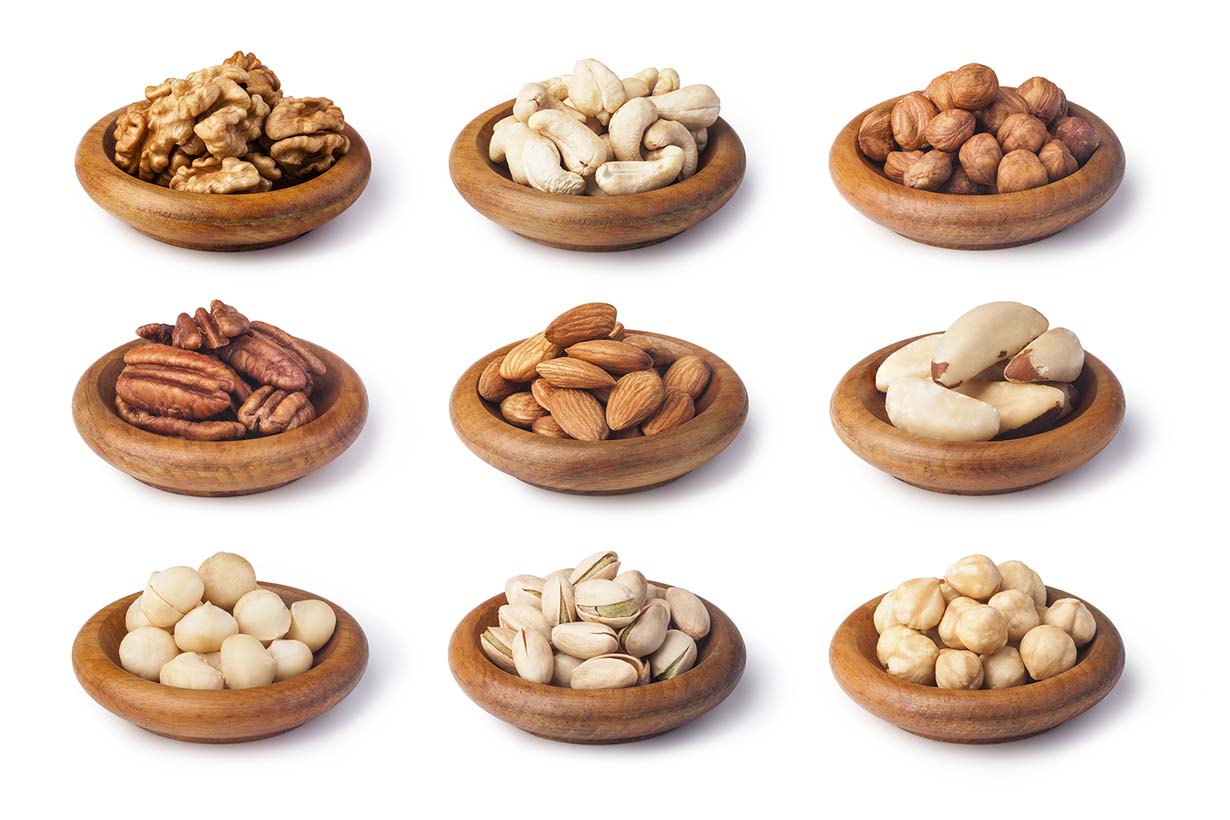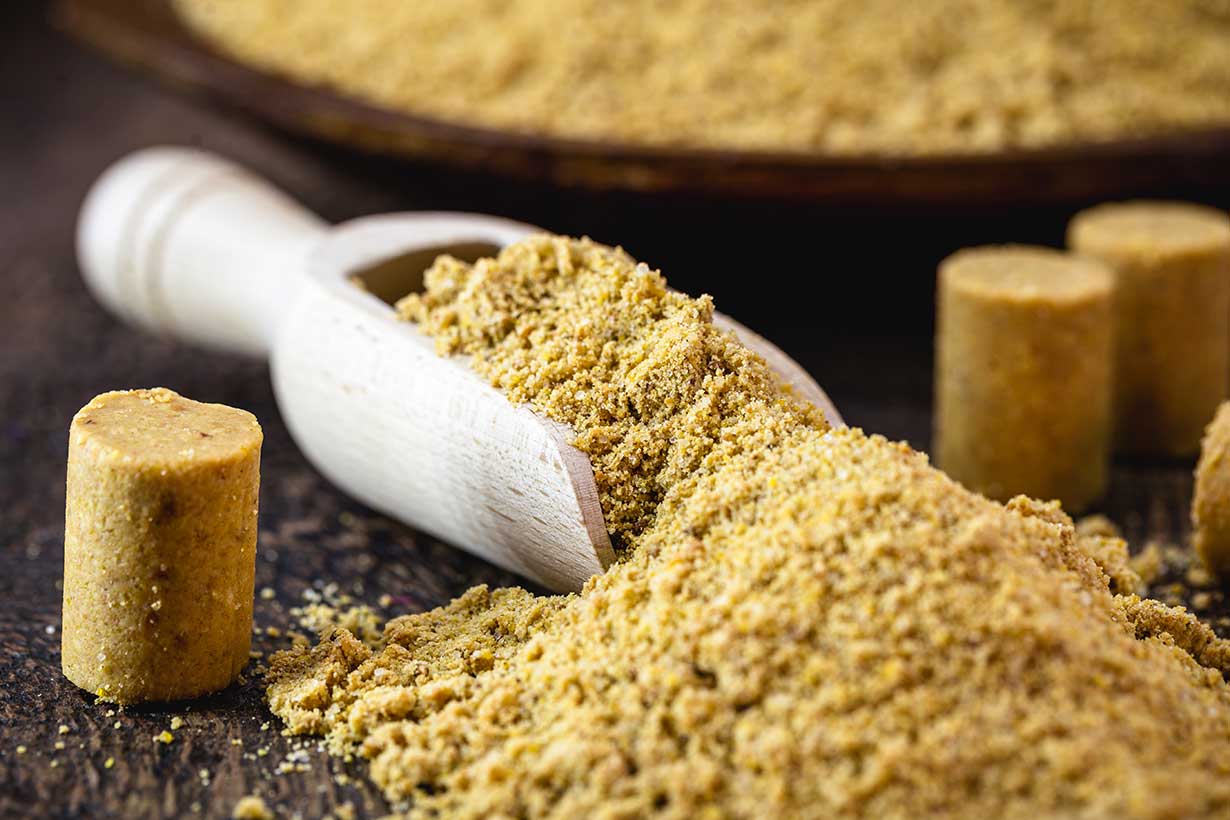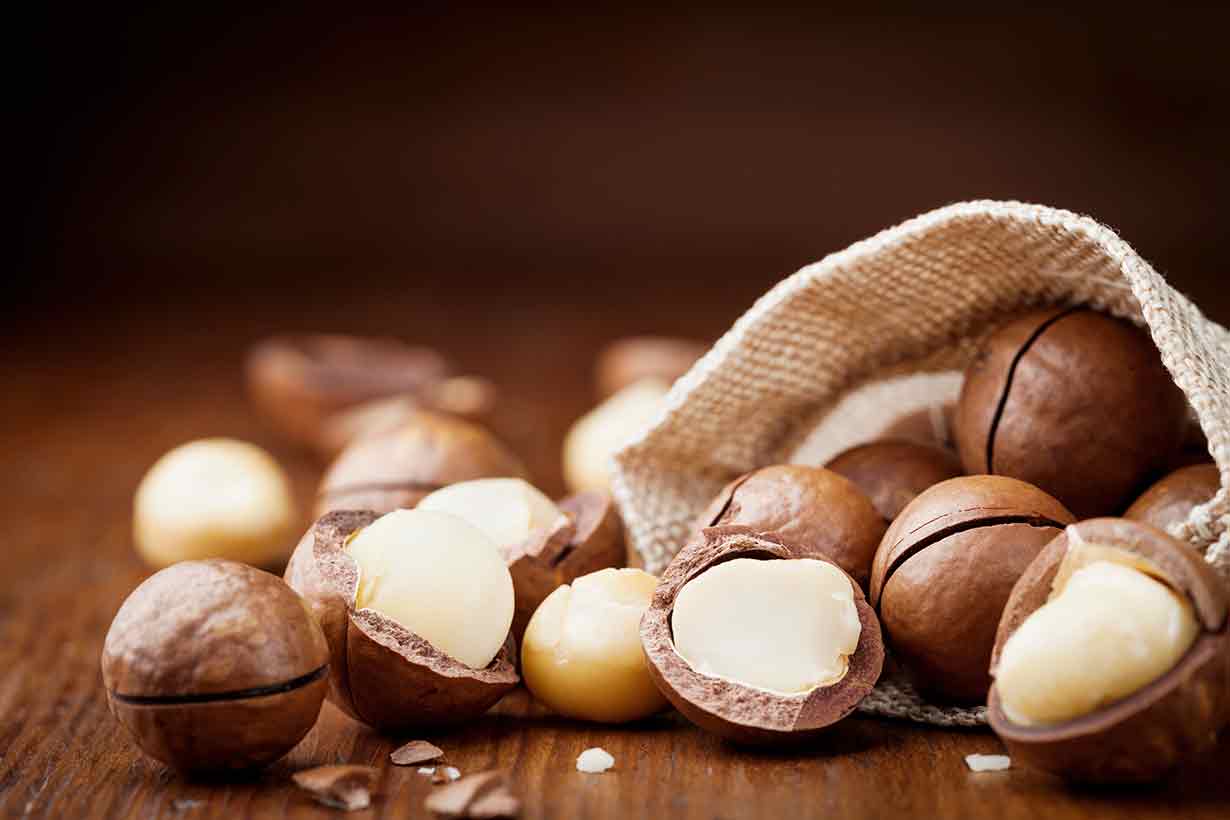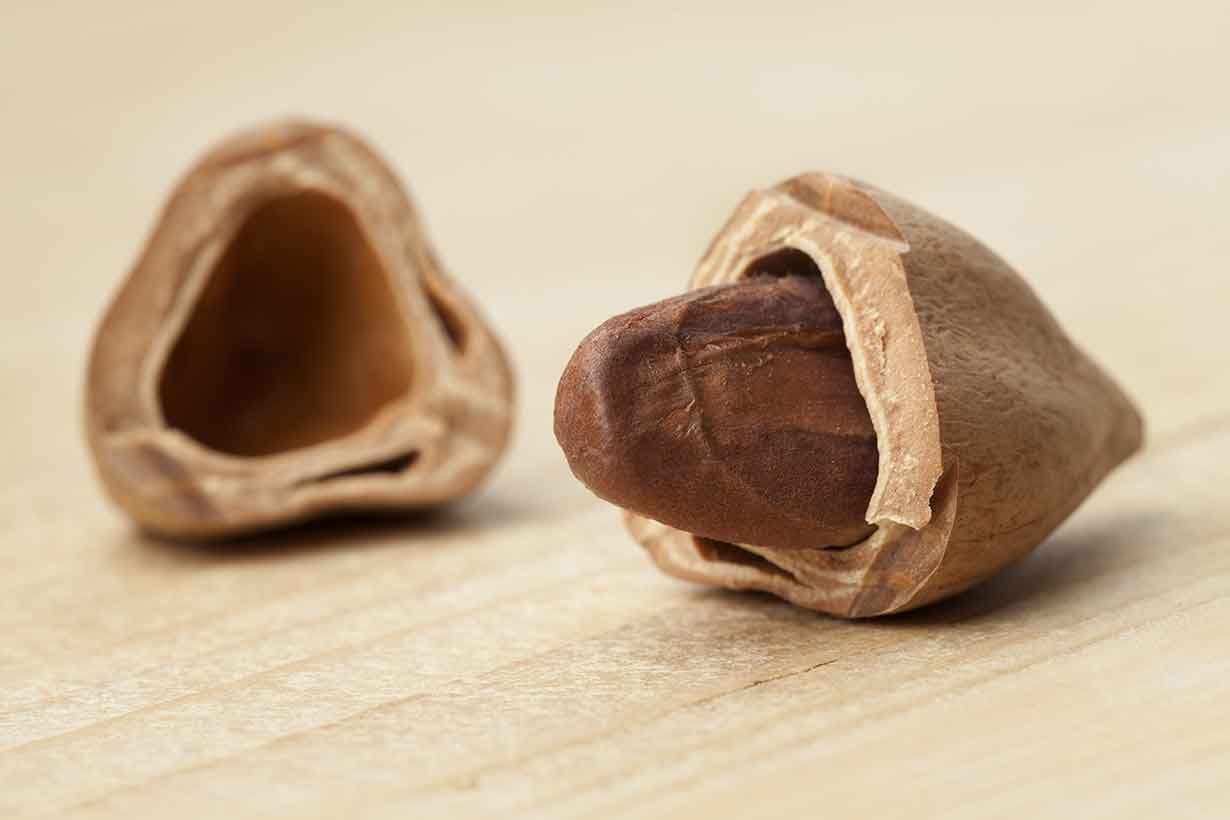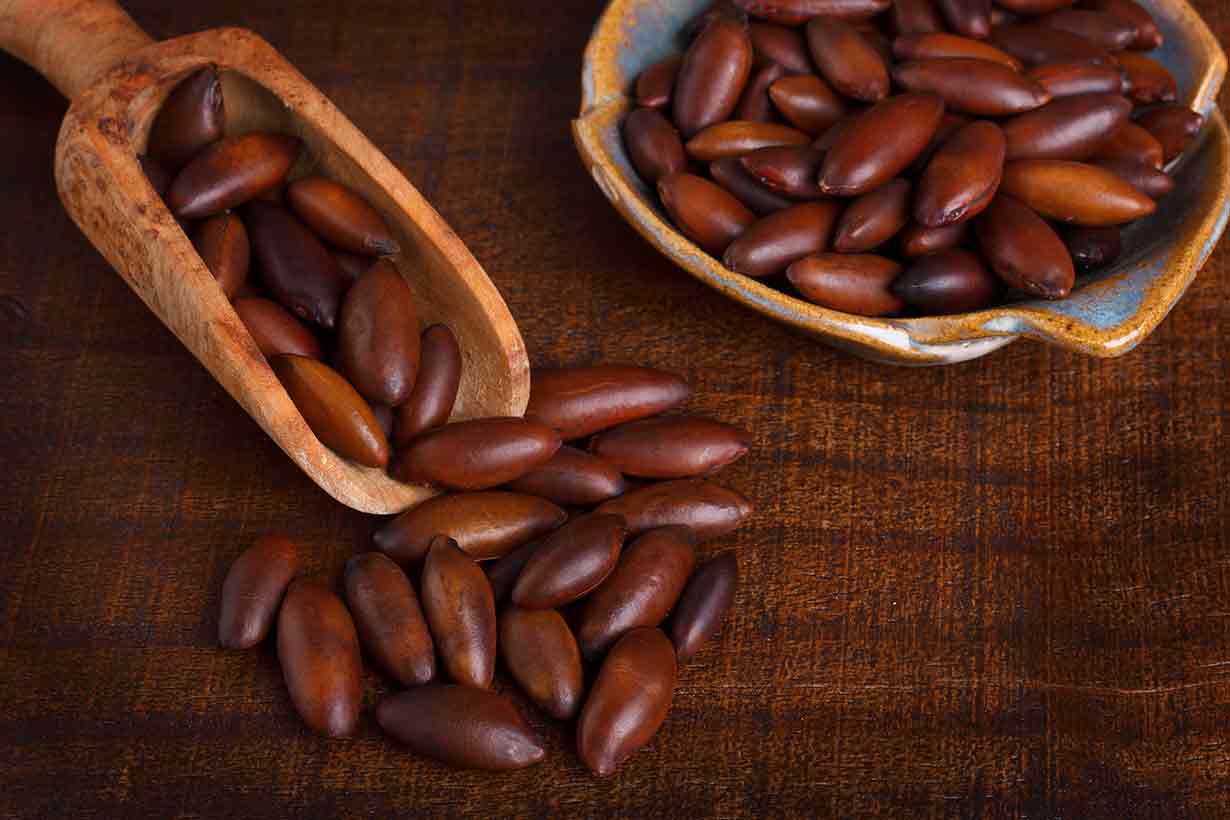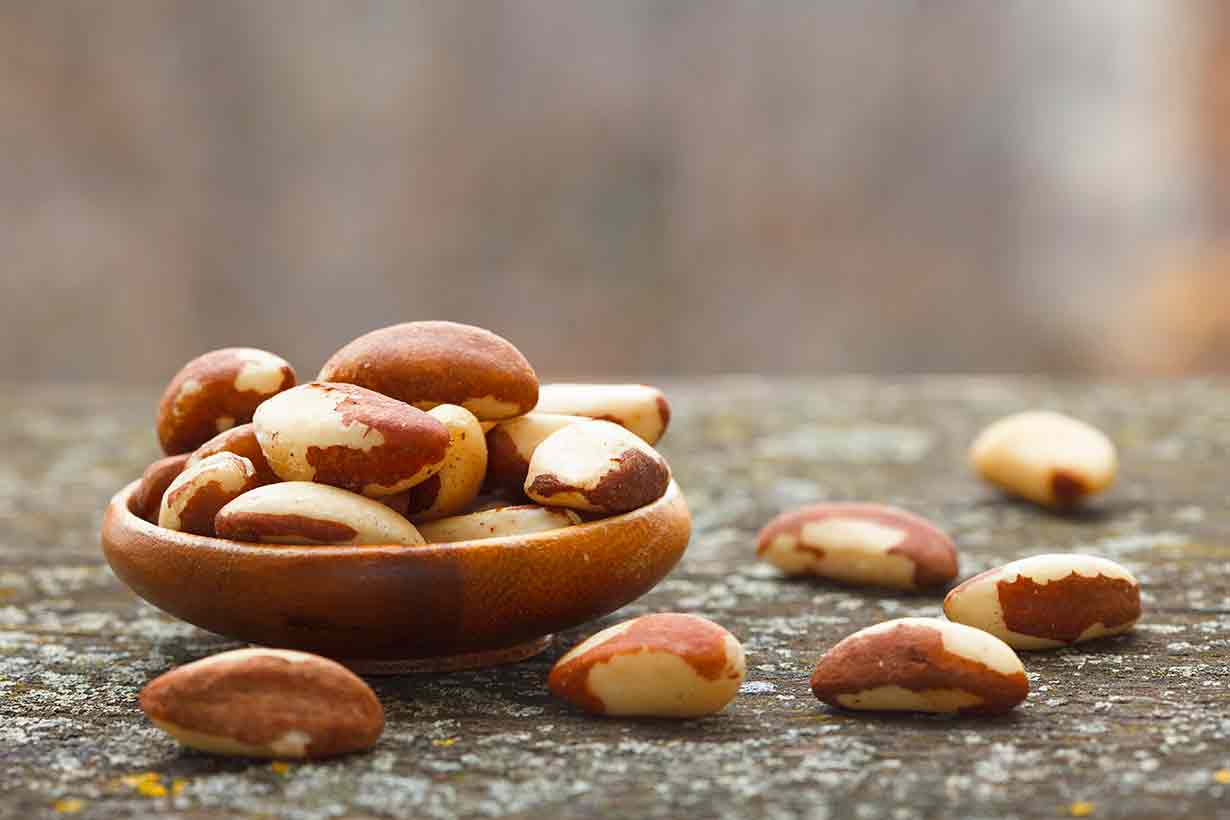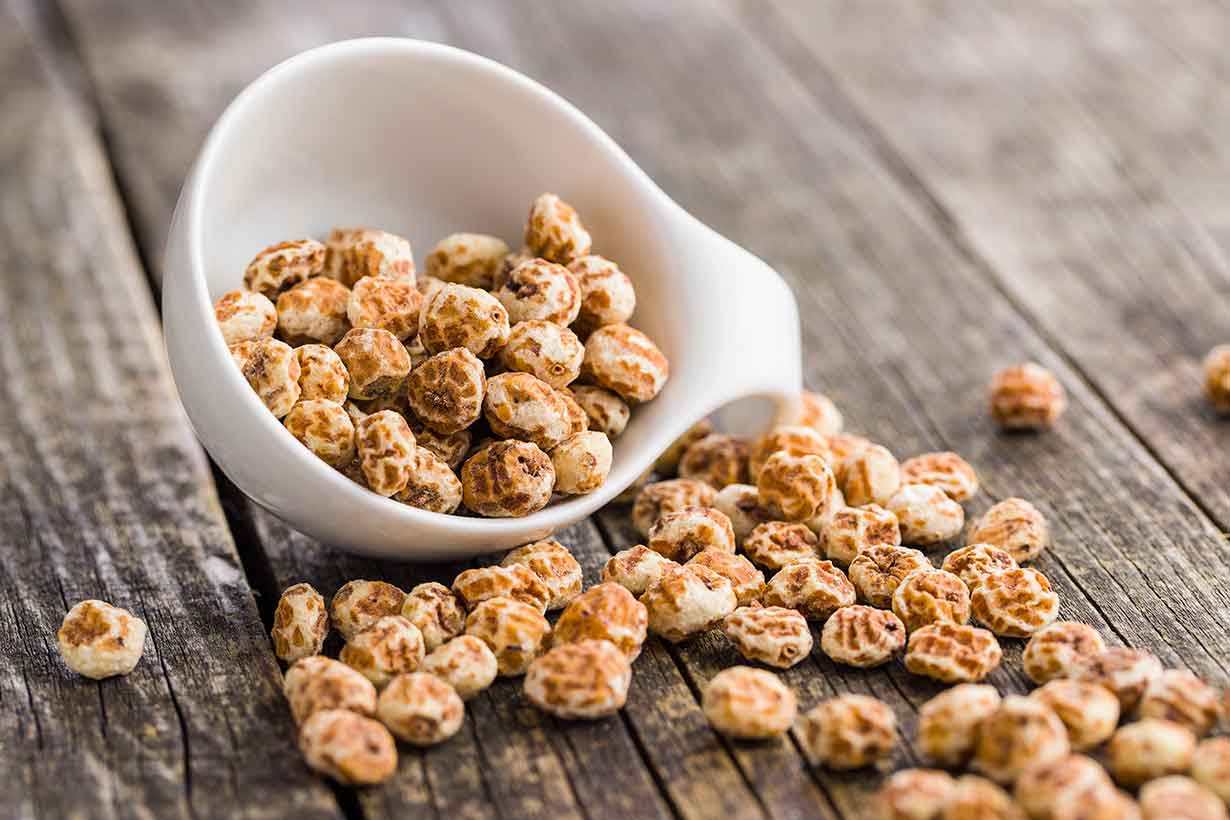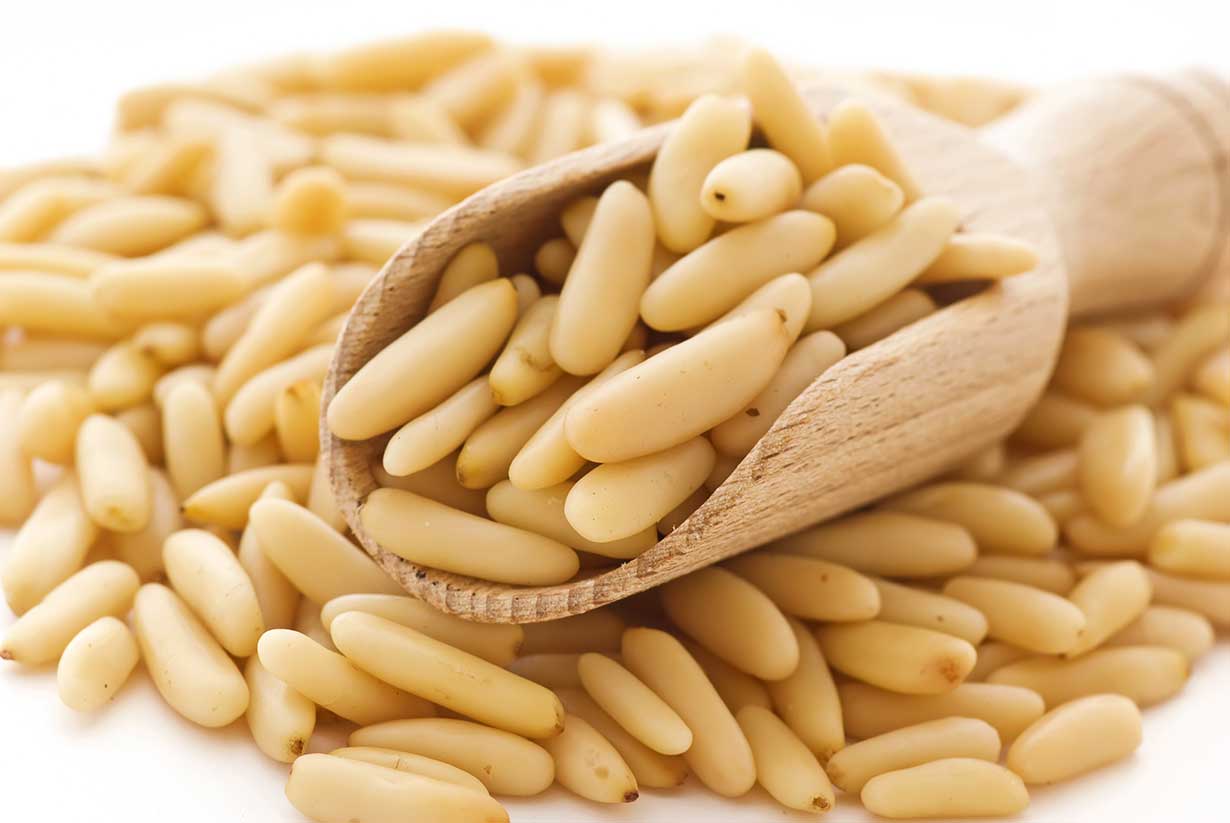Peanut butter is a delicious staple food found in households around the world.
However, these days there are many lesser-known ‘butters’ made from nuts too.
This article provides an in-depth guide to some of the most common nut butters and their nutritional values.
We also look at the pros and cons of using nut butters and provide some suggestions on how to use them.
1) Almond Butter
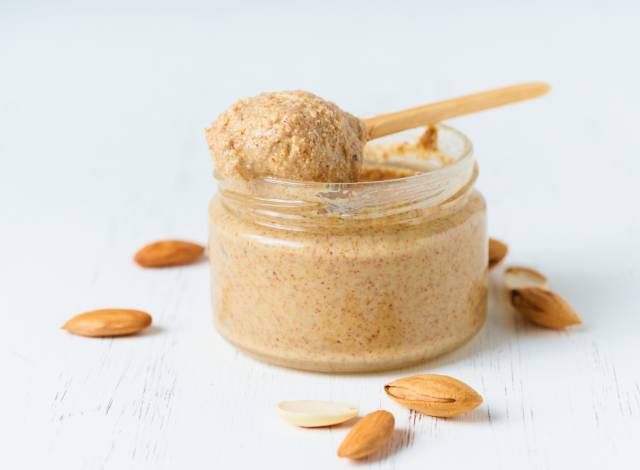
Almond butter is probably the most well-known type of nut butter after peanut, and it has become increasingly popular over recent years.
While the consistency and taste aren’t entirely different between almond and peanut butter, almond butter has stronger nutty flavors, and it isn’t quite as sweet.
According to the USDA nutrition database, here are the basic nutritional values per tablespoon serving of almond butter (1):
- Calories: 98 kcal
- Carbohydrate: 3.0 g
- Fiber: 1.7 g
- Sugars: 1.0 g
- Fat: 8.9 g
- Saturated: 1.05 g
- Monounsaturated: 5.2 g
- Polyunsaturated: 2.2 g
- Protein: 3.4 g
Just like regular whole almonds, almond butter provides an excellent source of vitamin E. A tablespoon serving offers 3.87 mg of vitamin E, equal to 26% of the daily value (1).
Uses
Almond butter works well in dips and salad dressings, and it can also be used as a dip itself for celery and carrot sticks.
Almonds aren’t quite as sweet-tasting as other nuts, so it is less suited to sweet/dessert recipes.
2) Brazil Nut Butter
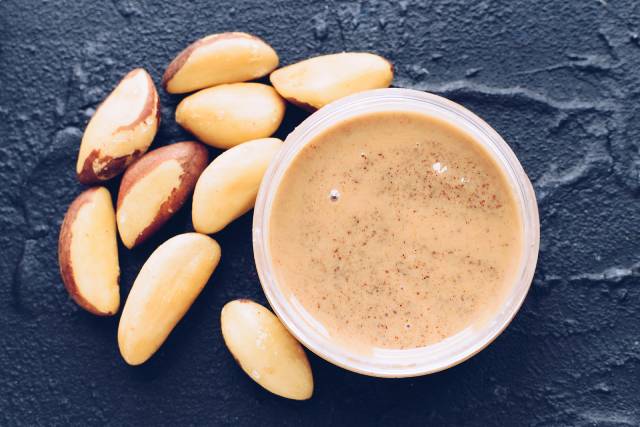
Brazil nut butter is available to buy, but it is currently one of the less common types of nut butter.
Similar to almond butter, Brazil nut butter has a very rich and nutty flavor. For those that like nutty flavors, this may be ideal, but it doesn’t have the mild sweetness that peanut butter has.
Since Brazil nuts are the best dietary source of selenium, Brazil nut butter will also provide a significant amount of this essential mineral.
Due to its relative newness, Brazil nut butter doesn’t currently have a listing on the USDA nutrition database.
However, here are the basic nutritional values per tablespoon, based on the ‘Futters Brazil Nut Butter’ brand (2):
- Calories: 95 kcal
- Carbohydrate: 2.0 g
- Fiber: 1.0 g
- Sugars: 0.5 g
- Fat: 9.5 g
- Saturated: 2 g
- Protein: 2.0 g
Uses
Brazil nut butter can be used in numerous ways, and it can be blended into salad dressings and smoothies or used as a dip.
3) Cashew Butter
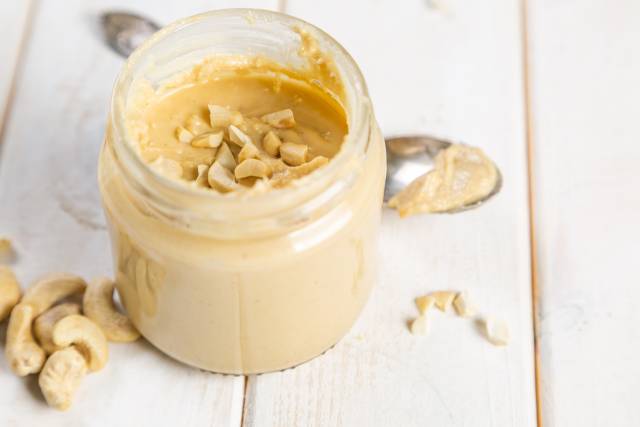
Cashew butter is arguably one of the best-tasting nut butters. It has a slightly sweet and only mildly nutty taste.
According to USDA data, a tablespoon of cashew butter offers the following nutritional values (3):
- Calories: 94 kcal
- Carbohydrate: 4.4 g
- Fiber: 0.3 g
- Sugars: 1.0 g
- Fat: 7.9 g
- Saturated: 1.6 g
- Monounsaturated: 4.7 g
- Polyunsaturated: 1.3 g
- Protein: 2.8 g
Just one serving of cashew butter also provides 350 mg of copper, which is equivalent to 39% of the mineral’s daily value (3).
Uses
Cashew butter’s mild flavor lends itself to a wide variety of uses.
For this reason, it can work well in a range of savory and sweet recipes, from desserts and smoothies to dips, salad dressings, soups, and stews.
4) Coconut Butter
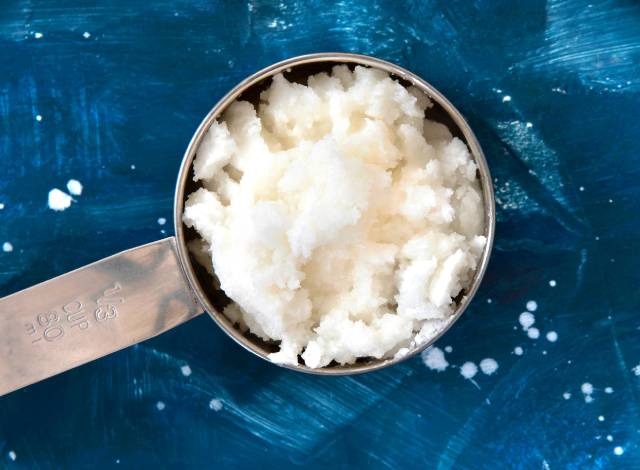
Coconut butter comes in different forms, and it is available in jars and as ‘creamed coconut’ bars.
While these products are basically the same and have an enjoyable sweet taste, ‘creamed coconut’ tends to cost a lot less than glass jars of coconut butter.
According to the USDA database, a typical coconut butter offers the following values per tablespoon (15.5g) serving (4):
- Calories: 110 kcal
- Carbohydrate: 4.0 g
- Fiber: 2.0 g
- Sugars: 1.0 g
- Fat: 10.0 g
- Saturated: 9.5 g
- Protein: 1.0 g
Uses
Coconut butter is delicious, and it even tastes good straight off the spoon.
This butter gives food a mild coconutty taste, and it also works as a slight thickener due to its fiber content. For this reason, coconut butter is well-suited to curries and spicy dishes in general.
Due to its sweet taste and coconut flavor, it also works well in all kinds of dessert recipes.
5) Hazelnut Butter
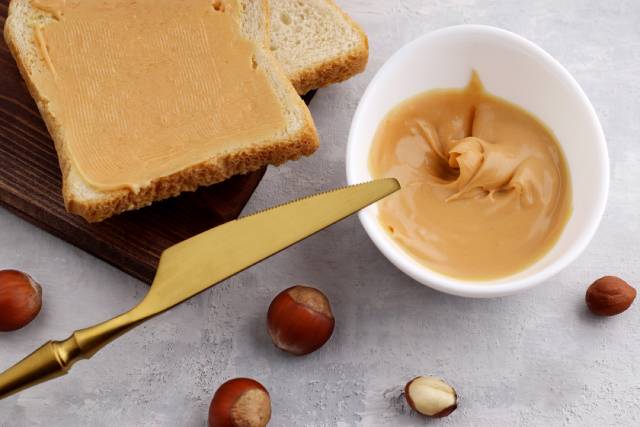
Hazelnuts are one of the tastier nuts, as is the nut butter made from them.
Unlike most other kinds of nut butters, hazelnut butter is sometimes sold in a mixed chocolate combination. This is due to the longstanding popularity of hazelnut and chocolate combinations, as seen with products like Nutella.
That said, here are the nutritional values per tablespoon of regular hazelnut butter (5):
- Calories: 94 kcal
- Carbohydrate: 2.6 g
- Fiber: 1.4 g
- Sugars: 0.7 g
- Fat: 9.1 g
- Saturated: 0.7 g
- Protein: 2.2 g
Uses
Hazelnut butter has a mildly sweet and creamy taste, and it will work well for giving some hazelnut flavoring to dessert-like recipes.
It will also work well in hot chocolate, blended into smoothies, or as a creamy topping on a piece of dark chocolate.
6) Macadamia Butter
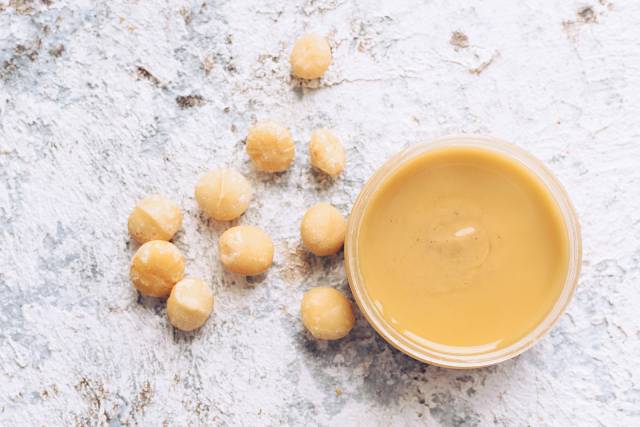
Macadamias have among the highest fat content out of popular commercial nuts. For this reason, macadamia nut butter has a smooth and creamy texture.
The taste is very mild as macadamia butter does not have the ‘nutty’ richness of butter made from almonds or Brazil nuts.
Per tablespoon serving, macadamia nut butter provides (6):
- Calories: 110 kcal
- Carbohydrate: 2.6 g
- Fiber: 1.0 g
- Sugars: 0 g
- Fat: 11.0 g
- Saturated: 1.0 g
- Protein: 1.0 g
Uses
Due to its mild taste and creamy texture, macadamia butter can be a versatile ingredient in various dishes.
For instance, it can be used as a smooth dip or spread, and it can fit well into dishes such as mild and creamy curries.
7) Peanut Butter (Smooth)
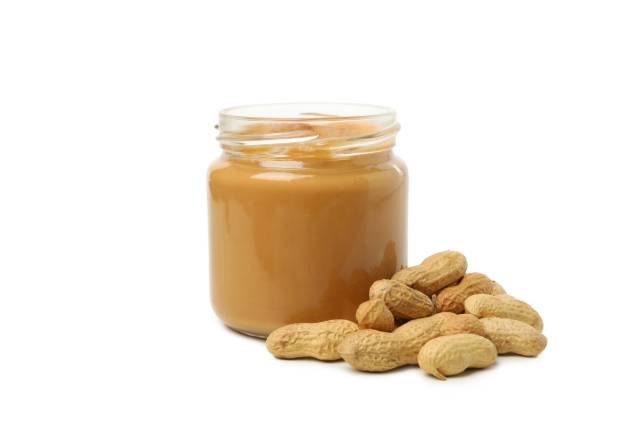
Peanut butter is the original nut butter. Apparently, the global peanut butter marker hit a $3.4 billion valuation in 2020 (7).
This isn’t overly surprising, as peanut butter can be found in most supermarkets (and many homes) around the world.
Despite not being a true tree nut (peanuts are legumes), peanut butter has a very “nutty” and flavorful taste.
Peanut butter comes in two popular varieties: smooth and crunchy.
Here are the nutritional values for smooth peanut butter per tablespoon (16-gram) serving (8):
- Calories: 96 kcal
- Carbohydrate: 3.6 g
- Fiber: 0.8 g
- Sugars: 1.7 g
- Fat: 8.2 g
- Saturated: 1.6 g
- Monounsaturated: 4.1 g
- Polyunsaturated: 2.0 g
- Protein: 3.6 g
Peanut butter is also available in powdered form, which contains higher amounts of protein and fiber but lower fat levels.
Uses
Peanut butter has many uses.
Some of the more popular ways to use this butter include toast, crackers, and sandwiches.
However, in some parts of the world, peanut butter is a vital ingredient in various curries and stews.
For some more ideas concerning this, see these 40 ‘surprisingly savory uses’ for peanut butter.
8) Peanut Butter (Crunchy)

Compared to the regular ‘smooth’ peanut butter, the crunchy variety still contains peanut pieces and has a thicker, crunchier texture.
There are some small nutritional differences too. Crunchy peanut butter provides higher amounts of fiber and protein and slightly less fat.
Per regular (16-gram) tablespoon serving, crunchy peanut butter has the following nutritional values (9):
- Calories: 95.0 kcal
- Carbohydrate: 3.5 g
- Fiber: 1.5 g
- Sugars: 1.0 g
- Fat: 8.0 g
- Saturated: 1.3 g
- Protein: 4.0 g
Uses
Crunchy peanut butter is very close to smooth peanut butter in terms of taste, and it tends to be used in the same ways.
9) Pecan Butter
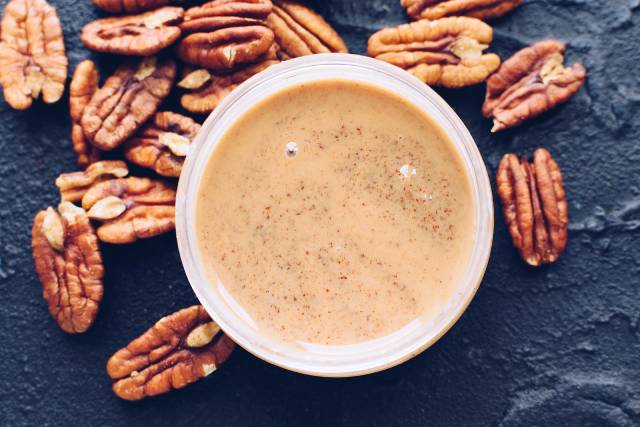
A tablespoon (15.5-gram) serving of pecan butter has the following nutrition profile (10):
- Calories: 110 kcal
- Carbohydrate: 2.0 g
- Fiber: 1.5 g
- Sugars: 0.5 g
- Fat: 11.5 g
- Saturated: 1.0 g
- Protein: 1.5 g
As shown in the nutritional values, pecan butter contains smaller amounts of carbohydrates and more fat than many other nut butters. For this reason, it has a smooth and somewhat runny consistency.
Uses
Since pecan butter is so smooth, it is easily spreadable, so it can be used on bread, crackers, etc.
Pecans are also very flavorful, which means the butter can give unique flavor notes when used in various dishes.
Mixing pecan butter with some melted dark chocolate (a 1:1 ratio is fine) also makes a healthier version of Nutella for those that like desserts.
10) Pistachio Butter
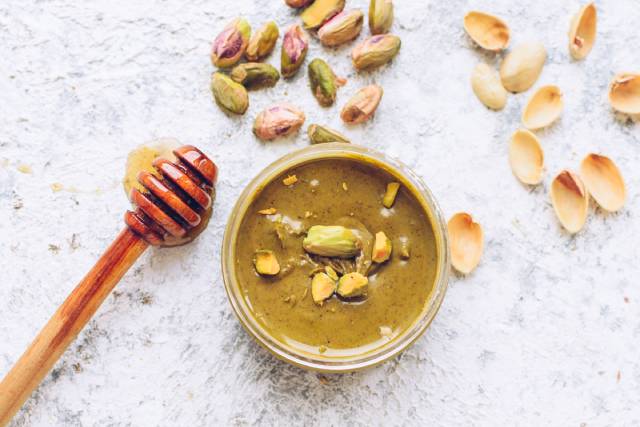
The first thing you notice about pistachio butter is the unusual greenish-brown color it has.
However, this is just the natural color of pistachios, and the butter tastes just as good as the nuts do.
Per tablespoon (16-gram) serving, pistachio butter’s nutrition profile is as follows (11):
- Calories: 90 kcal
- Carbohydrate: 4.5 g
- Fiber: 1.5 g
- Sugars: 1.0 g
- Fat: 6.5 g
- Saturated: 0.8 g
- Protein: 3.0 g
Pistachios are relatively low in fat and higher in carbohydrates compared to other nuts. For this reason, pistachio butter has a thick texture and a mildly sweet flavor.
Uses
Pistachio butter works best in dessert-style recipes and contributes a mildly sweet and creamy flavor.
11) Pine Nut Butter
Pine nut butter has a light and creamy texture, and a tablespoon (16-gram) serving has the following nutritional values (12):
- Calories: 110 kcal
- Carbohydrate: 2.0 g
- Fiber: 0.5 g
- Sugars: 0.5 g
- Fat: 11.0 g
- Saturated: 0.5 g
- Protein: 2.0 g
With its high fat content, pine nut butter has a smooth and easily spreadable consistency. It has a mild and buttery flavor.
One downside with pine nut butter is that, like the whole nuts, it can be difficult to find and expensive.
Uses
Pine nut butter spreads well, and it can be used with a variety of foods in this manner.
Due to its consistency, pine nut butter also works very well as a dip.
12) Walnut Butter
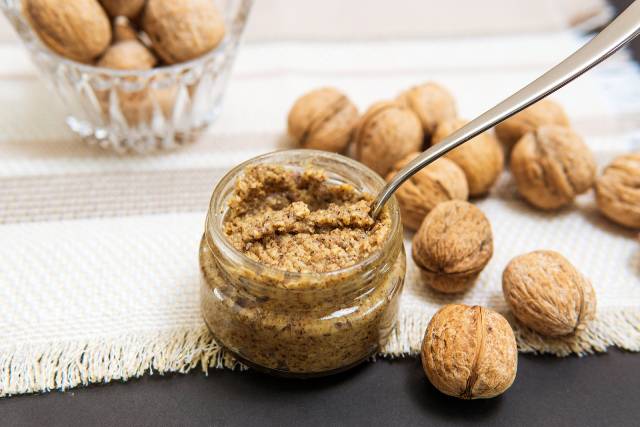
Walnut butter has a color that resembles peanut butter. However, it has a runny texture due to its much higher fat content.
Walnuts are one of the best plant-based sources of omega-3. Thus, this nut butter will provide a good amount of omega-3 in the form of alpha-linolenic acid (13).
Per tablespoon serving, walnut butter has the following nutrition profile (14):
- Calories: 105 kcal
- Carbohydrate: 2.2 g
- Fiber: 1.1 g
- Sugars: 0.4 g
- Fat: 10.5 g
- Saturated: 1.0 g
- Protein: 2.5 g
Walnut butter has a strong nutty flavor, and it is also quite oily.
In this regard, small amounts go a long way in adding flavor to other foods.
Uses
Since it is quite runny, walnut butter works well as a dip or for adding flavor to soups and stews.
Nutritional Comparison of Nut Butters
Here is an at-a-glance table offering a basic nutritional comparison of the various kinds of nut butter for convenience.
| Nut Butter | Calories | Carbohydrate | Fat | Protein |
|---|---|---|---|---|
| Almond butter | 98 kcal | 3.0g | 8.9g | 3.4g |
| Brazil nut butter | 95 kcal | 2.0g | 9.5g | 2.0g |
| Cashew butter | 94 kcal | 4.4g | 7.9g | 2.8g |
| Coconut butter | 110 kcal | 4.0g | 10.0g | 1.0g |
| Hazelnut butter | 94 kcal | 2.6g | 9.1g | 2.2g |
| Macadamia nut butter | 110 kcal | 2.6g | 11.0g | 1.0g |
| Peanut butter (smooth) | 96 kcal | 3.6g | 8.2g | 3.6g |
| Peanut butter (crunchy) | 95 kcal | 3.5g | 8.0g | 4.0g |
| Pecan butter | 110 kcal | 2.0g | 11.5g | 1.5g |
| Pistachio butter | 90 kcal | 4.3g | 6.5g | 3.0g |
| Pine nut butter | 110 kcal | 2.0g | 11.0g | 2.0g |
| Walnut butter | 105 kcal | 2.2g | 10.5g | 2.5g |
Other Considerations
It is important to note that these nut butters’ nutritional values may vary depending on the use of additional ingredients.
All nutritional values are based on products that contain no added oils or sugars.
Thus, as an example, peanut butter products containing vegetable oil or added sugar will have a slightly different nutritional profile.
Pros and Cons of Nut Butters
Nut butters can have some great benefits, but they also have some potential downsides.
Nutrients
On the one hand, nut butters are an easy and convenient way to get additional healthy fats, protein, fiber, vitamins, and minerals into the diet.
Conversely, they contain high amounts of fat (and thus calories) and are relatively easy to over-consume compared to whole nuts. For this reason, it is better to stick to regular serving sizes rather than sit down with a spoon and jar.
Also, some nut butter products can be high in sodium or saturated fat (coconut butter).
Anyone watching their intake of these two nutrients should be aware of this and carefully check the labeling of the product.
Price
Nut butter tends to be more expensive than regular whole nuts, as the required processing impacts the price.
One way to get around this is to buy whole nuts and make the nut butter at home, which we’ll look at shortly.
Allergies
Peanut and tree nut allergies are relatively common, so not all of these products will be suitable for everybody (15).
Try Making Homemade Nut Butter
Lastly, it is also worth noting that it is easy to make nut butter at home for those who have a food processor.
Making nut butter at home also tends to be a lot cheaper than buying a ready-made product.
Fortunately, homemade nut butter is simple and just requires the following steps:
- First, add nuts of choice to a decent food processor (disclosure: affiliate link)
- Optional: add a little salt for taste and to potentially help with storage life. It is also possible to add some oil, but this will again change the nutritional values (more calories, more fat).
- Next, turn the food processor on and wait.
As above, the process is simple, but it will take time for the nuts to develop the texture of nut butter. The whole process usually takes a little over 10 minutes, so patience is required.
Over time, the nuts will change from small chopped pieces to having a flour-like consistency.
As this change happens, the powder may start sticking to the side of the food processor. If this happens, just stop the processing for a minute and scrape the sides back into the middle with a spoon.
As time goes on, the oil will start being released from the nuts, and the flour-like texture will start becoming a paste.
After a little longer, the nut butter will be ready to spoon into a jar and store in the refrigerator.
Final Thoughts
There is a lot to like about the different nut butter varieties and the flavors they all contribute.
For those that value their convenience, they are an excellent source of nutrients and can fit into a healthy dietary pattern.

